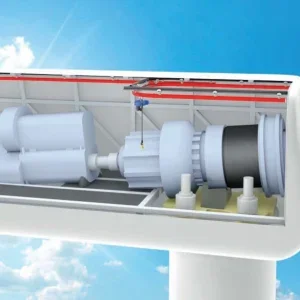
Electric bridge and gantry cranes provide a means of lifting and transporting loads over the area they cover. They can frequently be seen lifting and transporting heavy materials in construction and industrial applications. While some may use manual effort to lift, lower and move the load, it is more usual for some or, more typically, all of the crane’s motions to be electrically powered to handle a variety of loads efficiently and safely in a range of work environments.
Before the advent of modern control systems, most electric bridge and gantry cranes were cab controlled. The crane operator controls the crane from a cab mounted on the crane, which is usually fixed at one end of the crane bridge and travels with the bridge. There are still applications where cab control remains the best option, in particular those where the crane is in continuous use or the application requires lengthy long travel movements. The disadvantage of cab control is that the operator needs to be continuously on duty even when use is infrequent.
Another arrangement will see the cab fixed to the crab (the hoisting and cross travel mechanism of a double girder crane) allowing it to move with the crab. This has the advantage of giving the operator a view of the load, which might otherwise be obscured.
A third variation is a cab without controls from which the operator can control the crane using a pendant control or a remote control. This gives the option of cab control when appropriate, such as when the crane is in frequent use, yet retains the flexibility of control from other levels.
With pendant control, the crane operator controls the crane from a low, usually ground, level, using a push button box suspended from the crane. It is usually suspended from a track running across the crane bridge and connected by a festoon cable enabling it to be moved to any position. This has the advantage of enabling the operator to choose the best vantage point and also to negotiate any obstacles whilst using the long travel motion. Less popular arrangements are for the push button box to be suspended from a fixed point on the crane bridge or from the crab or hoist unit.
With remote control (cable-less controller), the crane operator controls the crane from a remote operator station without a cable connection to the crane. This has the advantage of enabling the operator to choose the best vantage point with virtually no limitations. Early forms of remote control were of the infra-red type similar, to the controls used on your television. A significant drawback was the need for a clear line of sight between the controller and the receiver mounted on the crane. These have largely been replaced by radio controls, which do not require line of sight.
SAFE AND IN CONTROL
Pendant and remote control allow operators to control the crane from a safe distance, away from hazardous areas or heavy loads. For both these means of control it is important to ensure the travel path is clear and free from obstructions before operating the crane. The operative must always have a clear view of the travelling hook path to ensure accidental hook engagement or collisions do not occur.
When using a remote control, it may be necessary to stop all motions to allow the operative to re-position to a better vantage point before proceeding. Users should ensure that the system is properly maintained, particularly the control station. Wear or damage to the seals around buttons or joysticks and damage to the casing enable dirt, water and other contaminants to enter which can cause false commands. There should be a designated storage place for the control station when not in use. Users should always press the stop button to deenergise the main contactor before leaving the control station unattended. This includes any occasion when the control station is temporarily set down such as might occur if the crane operative is also slinging the load.
Operatives using a pendant control in close proximity to the load should take care to stand clear before initiating a travel motion, which might cause the load to trap them. A pendant control should not be placed on the load because the weight of the pendant can operate a push button if the button rests on a small projection on the load. If, for any reason, it is necessary to place the pendant control on the load, it should first be deactivated by pressing the stop button.
For further guidance on controlling electric bridge and gantry cranes, see LEEA’s COPSULE (Code of Practice for the Safe Use of Lifting Equipment) which can be accessed for free at leeaint.com. For information specific to a particular crane, always seek the advice of the supplier and refer to the manufacturer’s instructions.
The latest version of LEEA’s guidance document ‘LEEA 046 – Guide to the application of remote controls for lifting machines, version 4’ is now available. This guidance is intended to serve as a starting point to those who specify, install and use remote controls with an overview of the relevant European & UK legislation, standards and current good practice.






